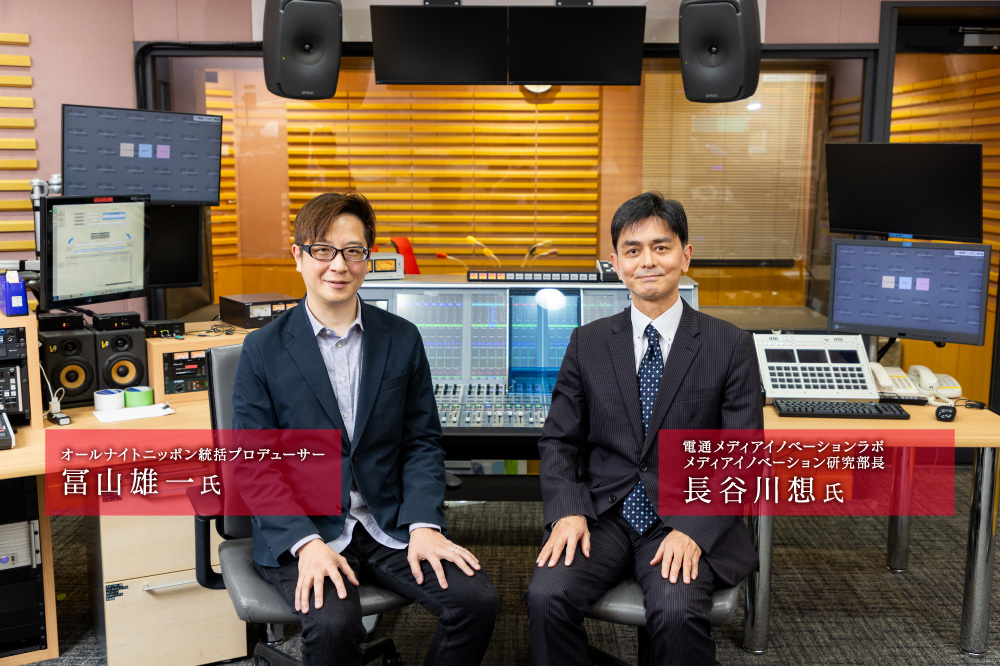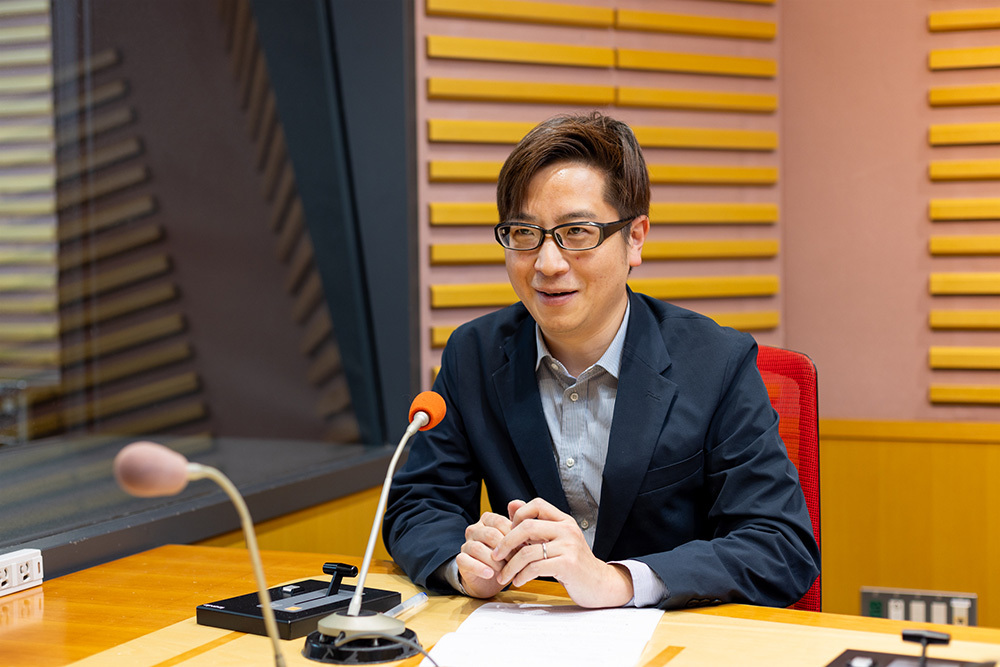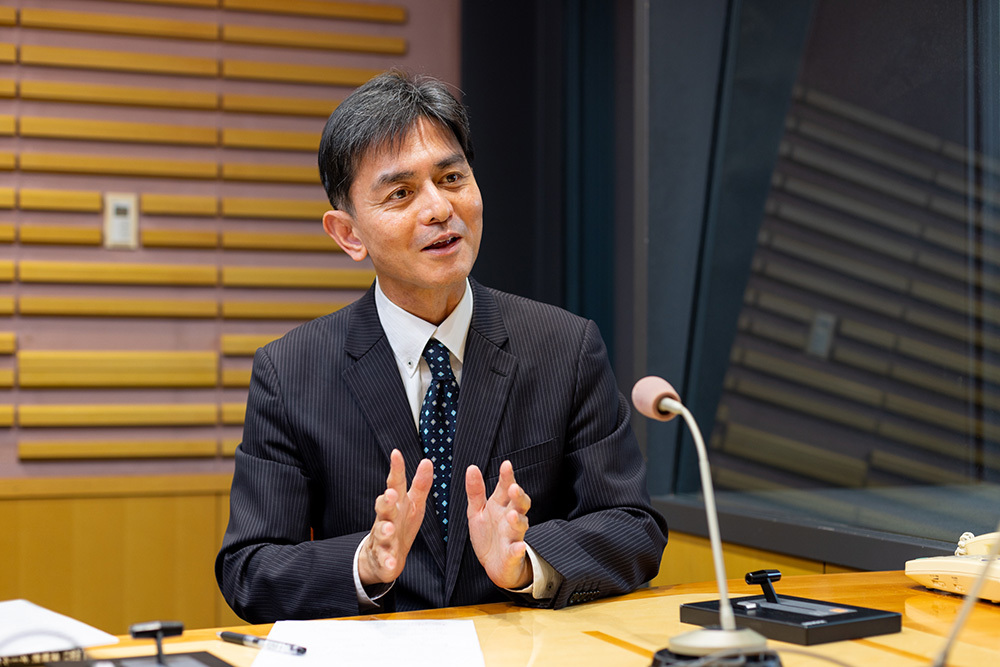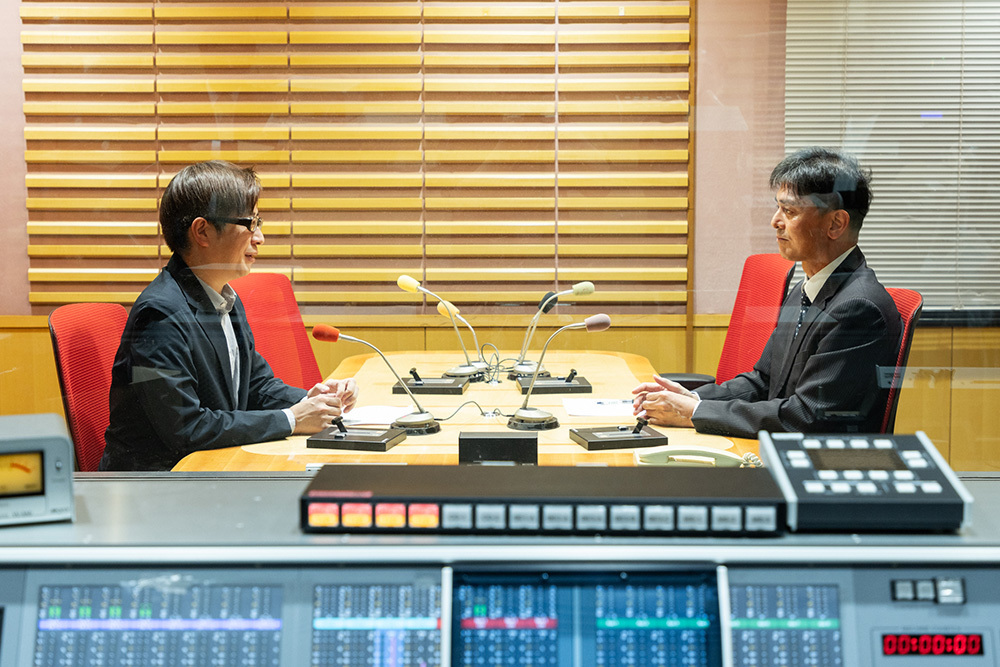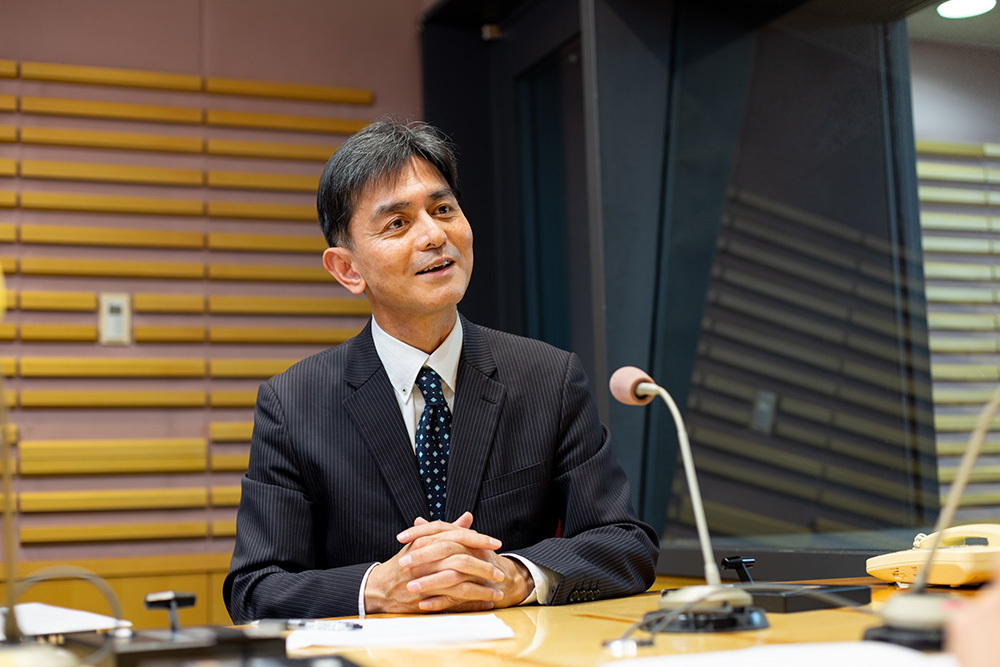On March 22, 2025, Japanese radio will celebrate its 100th anniversary. To mark this milestone, Dentsu-ho will feature interviews with key figures active on the front lines of radio. Our first guest is Yuichi Tomiyama, Executive Producer of All Night Nippon.
Fascinated by radio since junior high and having spent his career in the field, Tomiyama defines radio as a "community medium." Sō Hasegawa of Dentsu Inc. Media Innovation Lab spoke with Tomiyama about the changes radio has undergone in the 21st century and its future.
One catalyst for the start of radio broadcasting in Japan was the 1923 Great Kanto Earthquake. With Tokyo and Yokohama devastated and no way to share the extent of the damage, radio stations were the first to deliver information. This heightened the momentum for establishing radio stations, leading to Japan's first radio broadcast on March 22, 1925, by the Tokyo Broadcasting Station, the predecessor of NHK.
Now, in the 21st century, we're in an era where young people listen to radio the most.
Hasegawa: Thank you for having me today. Some may know you as the producer of All Night Nippon, Mr. Tomiyama, but please reintroduce yourself.
Tomiyama: Nice to meet you. After graduating university, I joined NHK in 2004 and was immediately assigned to the radio department, where I worked as a director for news and variety programs on NHK Radio 1. Later, I transferred to NHK Niigata Broadcasting Station and worked on television program production.
In 2007, I joined Nippon Broadcasting System mid-career. After serving as a director for All Night Nippon and morning/daytime programs for nine years, I worked in the events department, producing events for programs featuring Ninety-Nine's Takashi Okamura and Momoiro Clover Z. Since 2018, I've served as the producer for All Night Nippon, and currently oversee all program production at Nippon Broadcasting System.
Hasegawa: Mr. Tomiyama, you've spent most of your career in radio. Did you aspire to work in the radio industry since your student days?
Tomiyama: Yes. I started listening to radio in junior high, and All Night Nippon was one of my favorite shows. Radio felt like a "refuge" within my daily life—not school, not cram school—and it was comfortable. Even if I listened to a two-hour show late at night, I didn't remember the details. But amidst the worries unique to adolescence—studies, club activities, friendships—listening to radio made my heart feel just a little lighter.
Hasegawa: Having worked in radio for so long, how do you perceive its evolution?
Tomiyama: Compared to my student days, radio has truly changed dramatically. The twenty years since I joined NHK in 2004 were a period of upheaval.Back then, it was normal for every household to have a radio. But in the 2000s, with the rise of MP3 players like iPods that didn't have radio functionality, young people especially lost touch with radio. Then, in 2006, NicoNico Douga emerged as a new source for artists and culture, drawing young people's attention there. The early 2010s were a really tough time for radio.
Hasegawa: What was the turning point that changed the tide?
Tomiyama: I believe there were three major factors. First was the launch of radiko. When trial broadcasts began in 2010, it only offered simultaneous broadcasts. But in October 2016, the "Time Free" feature was introduced, allowing listeners to access programs anytime within a week of their original airing. This dramatically changed how radio was consumed.
Second was the widespread adoption of smartphones. Downloading the radiko app meant radio was always at your fingertips, unlike listening on a computer.
And third, the rise of social media. Radio had previously been a one-to-one medium between the personality and the listener, something enjoyed individually. But with Twitter (now X), people started tweeting (posting) their thoughts on programs using hashtags, transforming it into something where everyone shares the enjoyment together.
Hasegawa: So radiko, smartphones, and social media have had a huge impact on radio, right?
Tomiyama: Furthermore, the points of contact with audio content are rapidly increasing. Beyond radiko's real-time and time-free features, there are podcasts, of course, as well as audio distribution services like GERA, stand.fm, Voicy, and Radiotalk. By defining audio content as "radio," I often say, "Now, in the 21st century, we are in the era when young people listen to radio the most."
All Night Nippon is a morning show!?
Hasegawa: You mentioned "the era since the 21st century when young people listen to radio the most." How do listeners, especially young people, perceive radio?
Tomiyama: As radio has transitioned from analog to digital and various audio services emerged where you can listen to programs, the interpretation of radio has broadened to include "audio content you listen to on your smartphone" and "content where your favorite people are just talking, using only their voices."
All Night Nippon has several branded programs like "All Night Nippon X (Cross)," "All Night Nippon," and "All Night Nippon 0 (ZERO)." Listeners perceive it as "rich audio content where the personality speaks live every day." I believe this is a major factor in its ability to compete with platforms like YouTube, Instagram Live, and TikTok.
Hasegawa: How do you perceive the listener profile?
Tomiyama: Perhaps due to its image from the 70s and 80s, many people have this ingrained image of middle and high school students listening while rubbing sleepy eyes during exam season. However, looking at radiko's listening data, the main listener demographic is mid-20s, and there are also many listeners in their 30s to 50s who have been listening to the program for a long time.
From the station's perspective, All Night Nippon was traditionally seen as a late-night program for middle and high school students, with listeners constantly changing. However, realizing the audience spans a wide age range, the station is now aiming to build a loyal listener base over time, even keeping the same hosts for certain programs.
For example, Ninety-Nine has hosted their show for 30 years, and Audrey for 15 years. In 2024, to commemorate Audrey's 15th anniversary on All Night Nippon, they held an event at Tokyo Dome, drawing a combined audience of 160,000 people both at the venue and via livestream. Such a large-scale event was only possible because they built up their listener base over time; it wouldn't have been feasible after just two or three years on the show.
Hasegawa: I see. How do you analyze the factors behind the changing listener profile?
Tomiyama: Major factors include the spread of program content via social media and the time-shifting feature. For example, during All Night Nippon's live broadcast, tens of thousands of listeners nationwide tweet their reactions on social media, sharing what they found interesting. It's like an online meetup for the show happening every night. This content spreads as trending topics on social media, drawing in many listeners the next morning during their commute or school commute.All Night Nippon actually has six to seven times as many listeners during the morning hours as it does during the live broadcast.
Hasegawa: That's surprising.
Tomiyama: The personalities' comments also become online news. From announcements like a personality getting married or having a child, to everyday things like "this happened yesterday," it spreads instantly through social media and online news, even reaching people who don't listen to the radio.
It feels like a different world compared to my student days, when a few classmates would listen secretly, making it feel like a "secret base." I published my book "Radio's Golden Age is Now" in January 2025. What defines this golden age? I believe it's the first time in radio's 100-year history that the content and substance of radio programs have spread so widely throughout society.
How did radio transform into a "community media"?
Hasegawa: How do you perceive the changes in radio as a medium, given the evolving listener profile?
Tomiyama: First, fundamentally, radio has a role as mass media, with a mission to deliver information broadly and superficially to 120 million people. This hasn't changed. For example, during disasters, even if the power goes out, a radio powered by batteries can provide a lifeline for dozens of hours. From the perspective of broadcasting's role in "pursuing the public welfare," delivering accurate information to people nationwide will remain essential.
On the other hand, in today's world overflowing with content, the focus is shifting from creating content to satisfy 120 million people to reaching those who are already interested in specific programs or personalities in a narrower, deeper way. In that sense, I feel radio is evolving from mass media into community media.
Hasegawa: So it's community media?
Tomiyama: Originally, radio was a "one-way medium" where listeners tuned in to programs broadcast from receivers, becoming dedicated listeners to shows or personalities that captured their interest. It was fundamentally a one-on-one interaction between the personality and the listener. Now, however, listeners share and empathize with program content together. Through a single program, listeners share their emotions—joy, anger, sorrow, and pleasure—on social media.
Hasegawa: It's an era where you can recognize that there are other listeners just like you right beside you.
Tomiyama: In terms of radio culture, take All Night Nippon, for example. There are fans of the personality, and there are also listeners who simply enjoy late-night radio broadcasts. I often tell personalities that when both types of listeners tune in, the program really expands its reach.
Hasegawa: So it's not just the personality's die-hard fans listening to the radio.
Tomiyama: If you just want to create content for the personality's fans, YouTube, Instagram Live, or a fan club would suffice. The beauty of radio is that an unspecified number of people are listening.
Looking at radio as a whole, many people listen passively while doing other things, like using it as a clock. There are tons of "silent listeners" who don't post on social media, send postcards, or email. During the All Night Nippon time slot, there are also people driving or working late at night.
Given that context, radio programs exist in a state where "the door is slightly open," leaving room for newcomers to enter. By gradually incorporating such people and expanding the program's community, I believe a "quiet fervor" emerges.
Hasegawa: Regarding community, has the relationship between listeners, personalities, and staff changed?
Tomiyama: In the past, directors and broadcast writers rarely appeared on air, as the goal was to immerse listeners in a one-on-one world with the personality. Nowadays, however, the director in charge of the program, the broadcast writer, and even heavy listeners like the "postcard craftsmen" have their presence shared on social media.
This has created a trend where listeners say, "I like this writer, so I listen to the programs they work on." Now, staff actively promote shows on social media and even appear on air. The sense of camaraderie among listeners, personalities, and staff has grown stronger, and it's not uncommon for personalities to mention writers or staff during broadcasts.
Hasegawa: Audrey once said, "The radio studio feels like a high school club room." I think that feeling arises because radio is made by small teams.
Tomiyama: I agree. For All Night Nippon, the smallest production unit consists of six people: the host, director, mixer, AD, main writer, and sub-writer. Compared to TV shows, it's truly small-scale, and that fosters a sense of closeness among those involved. Add the listeners to that mix, and it creates a feeling of being like family – a close, intimate distance where everyone can talk about anything on the same level. It's a unique sense of distance specific to radio, something you don't find in other media.
Radio is like "traditional Chinese medicine"—its context and appeal seep in gradually.
Hasegawa: What do you think motivates young people of the "Taipa generation" to keep listening to radio for two hours straight?
Tomiyama: People are consuming audio and video content at double speed, short videos are trending, and overall content consumption time is steadily decreasing. Radio, however, is the complete opposite. All Night Nippon is a one- to two-hour program. The act of deliberately tuning in live late at night is probably perceived as fresh and novel by young people. Not just All Night Nippon, but the very essence of radio lies in its live, flow-based format. Its value is in sharing experiences that can only be felt in that exact moment.
Adding to that, while there's a lot of short-form content today seeking instant gratification, radio offers the fun of savoring context. For example, Audrey spends a very long time right from the program's opening talking about the week's events.
Hasegawa: When listening to live broadcasts, there's no fast-forward mode, right?
Tomiyama: Not just All Night Nippon, but radio listening easily becomes a habit. Like herbal medicine, the context and appeal of a show gradually reveal themselves over a year or two of listening. Meanwhile, short content on platforms like YouTube delivers instant, fleeting fun – like a quick-acting remedy. In today's content landscape saturated with such quick fixes, radio feels like a rare gem.
Then radiko's Time Free feature arrived, expanding how we enjoy shows. If All Night Nippon is like a festival, those listening live are the die-hard fans at the front row. Those listening via Time Free in the morning are fans standing further back, thinking, "Maybe I'll just peek in a bit."
When a broadcast features a surprise moment worthy of being called a "divine episode," the playback numbers skyrocket. It feels similar to when a surprise happens at a festival venue and everyone starts running towards it. Beyond the traditional listeners, I get the impression that the number of casual listeners has increased significantly.

Listeners and advertisers are promoting the program together
Hasegawa: Changing the subject slightly, how do you perceive the changes in advertiser marketing since the 2010s?
Tomiyama: For All Night Nippon, the number of advertisers per show was in the single digits in the early 2010s. Now it's increased significantly, with some shows having as many as 40 companies involved.
Hasegawa: Forty companies!
Tomiyama: That shows advertisers recognize All Night Nippon's value, but it's not just about high ratings. Recently, listeners' feelings toward advertisers have changed. Before, they might just think, "Oh, a commercial's playing." Now, they share and empathize with the commercials together. The idea that advertisers support radio programs has really sunk in with listeners, creating an atmosphere where listeners and advertisers are promoting the show together.
Hasegawa: Earlier, you mentioned radio being a community medium, implying advertisers feel like part of the community too. How did that sense of belonging develop?
Tomiyama: Fundamentally, radio makes it easy for listeners to connect with a program's sponsor.Listening weekly, you immediately recall that Meiji sponsors Nobuyuki Sakuma's "All Night Nippon 0 (ZERO)" and Mitsukan sponsors Fumiya Takahashi's "All Night Nippon X (CROSS)". Additionally, lately listeners increasingly post about commercials and advertisers on social media, and personalities also talk more about advertisers.
Hasegawa: I see. So there's this unique bond between advertisers and listeners that TV doesn't have. How do you think we should respond to advertisers' future needs?
Tomiyama: Currently, most ads reach all listeners. However, as we transition from analog to digital, we believe there's a growing demand to leverage listening data and pinpoint ads to the exact target audience. We expect radiko's audio ads and podcast advertisements to meet this need.
May it remain a medium where we can all share our feelings, even 100 years from now.
Hasegawa: Finally, could you share your thoughts on the future of radio?
Tomiyama: I think radio is like an amoeba. Individually, it's not as strong as other mass media. That's why I believe it has survived for 100 years by flexibly incorporating various services and media to overcome change.
Hasegawa: So radio adapts flexibly with the times.
Tomiyama: That said, there are things we want to preserve forever. When the 2024 Noto Peninsula Earthquake struck, Hoshino Gen canceled a pre-recorded New Year's program and went live instead. During that broadcast, he told listeners, "Let's feel anxious together."
Those words struck a chord with me. Normally, it might have been a more one-sided message like "Let's do our best" or "Everything will be okay." It made me realize anew that radio is a medium that can accompany everyday anxieties and allow everyone to share their feelings together.
Radio broadcasting began in Japan following the 1923 Great Kanto Earthquake. I strongly hope that radio will continue to be a medium that swiftly delivers information and allows us to share our feelings together, even 50 or 100 years from now.
Hasegawa: Thank you for sharing your insights today.







